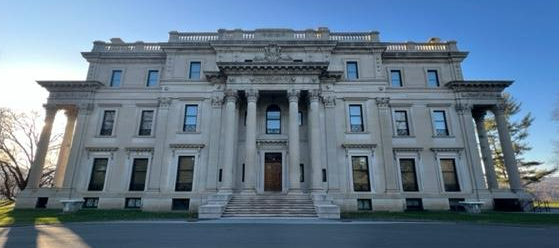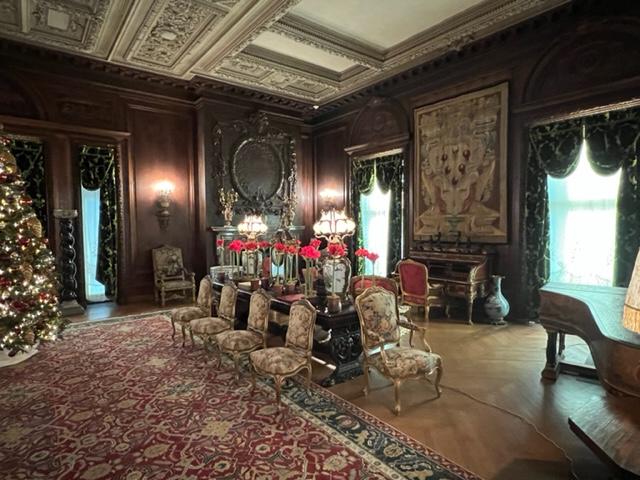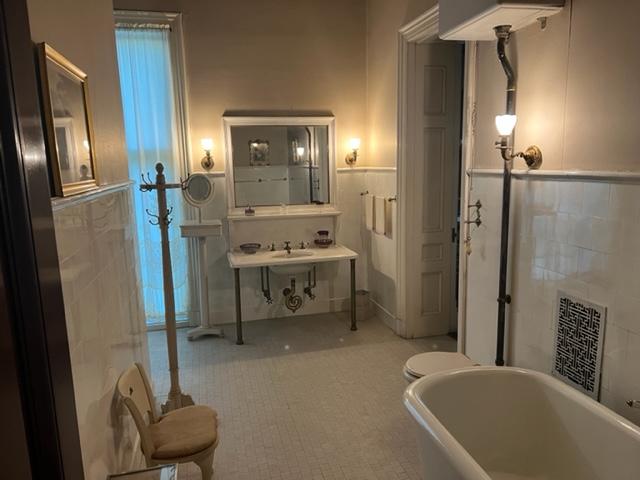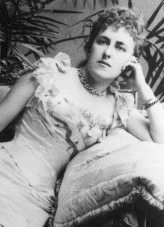The Vanderbilt Mansion & Estate
National Historic Site
4097 Albany Post Road
Hyde Park, NY 12538
(845) 229-7770
https://www.nationalparks.org/explore-parks/vanderbilt-mansion-national-historic-site
TripAdvisor Review:

I have visited the Vanderbilt Estate many times over the years and every time I visit I learn something new about the family and about the property. It takes many visits to truly see the beauty of the house and grounds.

The Vanderbilt Mansion foyer on the first floor decorated for the holidays
I found the best time to visit is in the late Spring as the buds are coming in and Christmas time when the house is decorated for the holidays. It is quite spectacular. The holiday tour is amazing and after Thanksgiving, make a special trip to the Hudson River Valley and go mansion hopping as all the houses are decorated for the holidays.

The Christmas tree in the library of the Vanderbilt Mansion
The tour will take you to three floors of the house: the first floor with the living room, dining room, parlors, and studies. Then there is the second floor with Fredrick, Louise and the guest family and single women rooms. The last floor you will visit is the basement workrooms, servant quarters and kitchen.
On the first floor is the formal dining room and the library, the offices of both Fredrick and Louise for their social and business obligations and the formal receiving foyer of the home. Things were decorated for the Christmas holiday season and it gave a very festive appearance.

The Library was set up for the Christmas holidays

The other side of the Library for the Christmas holidays
The house was only used about four months out of the year, being used in the Spring and then again in the Fall from the end of September to right after Thanksgiving and then the family would go to New York City for the social season. After Louise’s death, Fredrick sold his other houses and moved here permanently. The house was used full time and Fredrick must have enjoyed his time here.
When she was alive, they used to have a very active social life and were active in local affairs. The formal dining room was used for parties and get togethers. For the holiday season, the room was decorated for a formal Christmas dinner.

The Dining Room set for holiday dinner

The beautiful fireplaces and paneling of the Dining Room

The Dining Room table set for the Christmas holidays
The formal staircase takes you up the to the bedrooms and the formal baths. The house was one of the first in the community to have electricity and hot and cold running water with all modern plumbing.

The stairs were wide and long due to the ladies dresses of the time

The artwork on the walls and landings was just breathtaking

The artwork on the landings and hallways is magnificent
The bedrooms on the second floor are as elaborate as the rest of the house. While Fredrick’s bedroom was very plain in comparison to Louise’s who designed her bedroom after Marie Antoinette’s that she saw at Versailles. The room has a railing around it.

Louise’s Bedroom was based on what she saw in Europe.

Fredrick’s bedroom is less formal

The Bathroom with its modern plumbing and lighting

The elaborate rooms of the Vanderbilt Mansion

The household had a staff of over thirty people to attend to the household and grounds with their formal gardens. The kitchen staff had a well attended kitchen to work with and according to the tour guide, the staff was well treated at the Vanderbilt mansion. Fredrick was a good boss and provided well for his loyal staff.

The basement kitchen of the Vanderbilt Mansion
Touring the Vanderbilt Mansion at the Christmas holidays is always a treat but if you miss it, you can go during the year and still the elaborate rooms and beautiful grounds during the summer months. Take time to walk around the extensive lawns and gardens.
History of the Vanderbilt Mansion:
The Gilded Age, the period following the Civil War to the turn of the century, was a time of unparalleled growth in industry, technology and immigration. Captains of industry, men like Cornelius Vanderbilt, Andrew Carnegie, J.P. Morgan, John D. Rockefeller and others who amassed unimaginable wealth, while the average annual income in the US was around $380, well below the poverty line.
The term “Gilded Age” was coined by Mark Twain and Charles Dudley Warner in their 1873 book, The Gilded Age: A Tale of Today. The term refers to the process of gilding an object with a superficial layer of gold to improve its appearance. Established millionaires viewed nouveau riche families like the Vanderbilt’s, who flaunted their wealth by building ostentatious homes, throwing extravagant balls and using their money to buy social prominence, as gilded-all show, no substance.
Cornelius “Commodore” Vanderbilt (1794-1877) rose from poverty to become a shipping and railroad tycoon. He turned a 100 dollar loan from his parents into a multi-million dollar fortune and left the bulk of his money to his eldest son William.
William expanded the railroad operations doubling the Vanderbilt fortune in just eight years but his eight children lived lives of excess, extravagance and self-indulgence. They built 40 opulent mansions and country estates and entertained lavishly, largely depleting the family money.

Fredrick William Vanderbilt later in life
In 1895, William’s son, Fredrick (1856-1938) and his wife, Louise (1854-1926) bought Hyde Park to use its their spring and fall country estate. McKim, Mead & White, America’s top architecture firm, designated the mansion in the neoclassical style with Beaux-Arts ornamentation and incorporated the latest innovations: electricity, central heating and indoor plumbing. They added the Pavilion, a coach house, power station, gate houses, two new bridges over Crum Elbow Creek, boat docks, a railroad station and extensive landscaping. Many of the mansion’s contents were bought in Europe from wealthy families who had fallen on hard times. Furnishings and construction coast totaled around $2,250,000.

Louise Vanderbilt
Hyde Park was in many ways self-sustaining, providing food and flowers for the family’s needs here and at their other homes. When the Vanderbilt’s were in residence, as many as 60 staff worked here. Staff lived on or near the property and attended to the grounds and extensive farm. Personal staff traveled with the Vanderbilt’s and lived in the mansion with the family. Seasonal laborers were hired from the community and lived in the servants’ quarters.

The Vanderbilt Mansion in Hyde Park, NY
Fredrick, a quiet man, preferred to avoid social occasions but Louise loved to entertain, throwing lavish weekend parties with horseback riding, golf , tennis and swimming followed by formal dinners and dancing. When Louise died in 1926, Fredrick sold his other houses and returned to this estate for the last 12 years of his life. He was active in business, directing 22 railroads until his death in 1938. His estate totaled $76 million, over 1.2 billion today.
Gilded Age estates like this flourished in the 1890’s until the income tax (1913), World War I (1914) and Great Depression (1930’s) made their upkeep all but impossible.
The couple had no children and left the Hyde Park mansion to Louise’s niece, Margaret Louise Van Alen, who tried to sell the estate but there were no buyers. Her neighbor, Franklin D. Roosevelt, suggested she donate the estate to the National Park Service as a monument to the Gilded Age. She agreed and the Vanderbilt Mansion National Historic Site opened to the public in 1940. The farmlands were not part of the donation and remain in private hands. The lavish mansion and its contents remain virtually unchanged from the time the Vanderbilt’s lived here.
(The National Park Foundation pamphlet)
The Vanderbilt Family History:
1650: Jan Aertsen Van Der Bilt is the first Vanderbilt ancestor known to reside in American.
1794: Cornelius “Commodore” Vanderbilt born on Staten Island, New York City, to Cornelius and Phoebe Hand Vanderbilt.
1810: Cornelius borrows $100 from parents and buys first two-masted sailing barge to start a ferry service from Staten Island to Manhattan.
1817: Cornelius captains a steamship for Thomas Gibbons and assists in legal battle against steamship monopolies, opening the way for his own shipping business.
1821: William Henry Vanderbilt, one of 13 children and first son, born Cornelius and first wife Sophia.
1830’s-1840’s: Cornelius expands shipping empire, begins railroad management.
1841: William marries Maria Kissam. They have eight children.
1851: Cornelius’ Accessory Transit Company provides shorter, cheaper transportation from New York to San Francisco. He gains national prominence.
1856: Fredrick, sixth child, is born to William and Maria
1861-65: During the Civil War, Cornelius donates steamship to the Union Navy. Receives Congressional Gold Medal. Acquires and consolidates rail lines in the Northeast and Midwest.
1870’s: Cornelius consolidates two core companies, creating New York Central & Hudson Railroad. William slashes cost, increases efficiency, turning it into one of the most profitable large enterprises in America.
1871: Cornelius opens Grand Central Depot on 42nd Street, New York City, the largest train station in North America
1877: Cornelius dies. William inherits most of his father’s fortune, nearly $100 million, to great displeasure of his siblings.
1878: Fredrick graduates from Sheffield Scientific School (Yale). Marries Louise Anthony.
1885: William dies, leaving an estate of $195 million to his eight children.
1895: Fredrick and Louise purchase the Hyde Park estate.
1899: Grand Central Depot is enlarged and becomes Grand Central Station.
1904-13: The new Grand Central Terminal (GCT) is built in sections on Depot site. Design insures trains are not delayed.
1926: Louise dies.
1938: Fredrick dies, leave the Hyde Park estate to niece Margaret Louise Van Alen.
1940: Vanderbilt Mansion National Historic Site established.
1949: 65 million passengers pass through GCT, equivalent 40% of the American population.
1950: Glory days of rail travel end.
1967: GCT designated New York City landmark, saving it from demolition.
1968: New York Central merges with Pennsylvania Railroad to form Penn Central.
1970: Penn Central files for bankruptcy and is dissolved by the courts.
1994: Metro-North takes over the GCT operation and restores it to 1913 splendor.
(The National Park Foundation pamphlet)
A legacy of landscape design:
The estate’s landscape was first developed by Dr. Samuel Bard, who died here in 1821. In the European picturesque style, he planted exotic plants and probably the gingko tree, one of the continent’s oldest dating back to 1799. Bard’s son, William sold the to his father’s medical partner, Dr. David Hosack, who built the first formal gardens and greenhouses. After his death, the estate was broken up. Later Walter Langdon Jr. reunited the estate, laid out the formal garden’s and hired Boston architects to design a gardener’s cottage, tool houses and garden walls. These structures, the only ones to pre-date Vanderbilt ownership, still exists. Vanderbilt redesigned the formal gardens and planted hundreds of trees and shrubs. On weekends, Fredrick and Louise liked to walk through the gardens twice a day. Today the landscape, restored to its 1930’s appearance, encompassing five acres of tiered gardens, gravel paths, shady arbors, ornate statues and bubbling fountains.
(The National Park Foundation pamphlet)
Disclaimer: This information comes directly from the National Park Service pamphlet of the Vanderbilt Estate and I give the author full credit on the information. Please refer to the National Park System website for any further information on the site as the hours vary during the different times of the year.
- A Local Journey out of Manhattan
- Decorated Homes at Christmas in the Hudson River Valley
- Experiences and Tours
- Exploring Historic Dutchess County NY
- Exploring Historic Rhinebeck NY
- Exploring Hyde Park, NY
- Exploring the Historical Hudson River Valley
- Exploring the Hudson River Valley
- Gilded Age homes of the Hudson River Valley
- Historic Homes in New York
- Historic Homes of the Hudson River Valley
- Historic Sites of New York State
- Parks and Historical Sites
- Small Historical Societies in New York State
- Small Museums and Galleries in New York State
- Uncategorized
- VisitingaMuseum.com
- Walking Downtown Hyde Park, NY


The best time to come is holiday time when all the Hudson River homes are decorated for Christmas. Check the National Park website for more details.
LikeLiked by 1 person
Reblogged this on mywalkinmanhattan and commented:
Don’t miss the Vanderbilt Mansion when it is decorated for Christmas.
LikeLiked by 1 person
I revisited the Vanderbilt estate again for Christmas 2022 and the mansion was decorated to the hilt. It is so nice to see it. It will put you in the Christmas spirit.
LikeLiked by 1 person